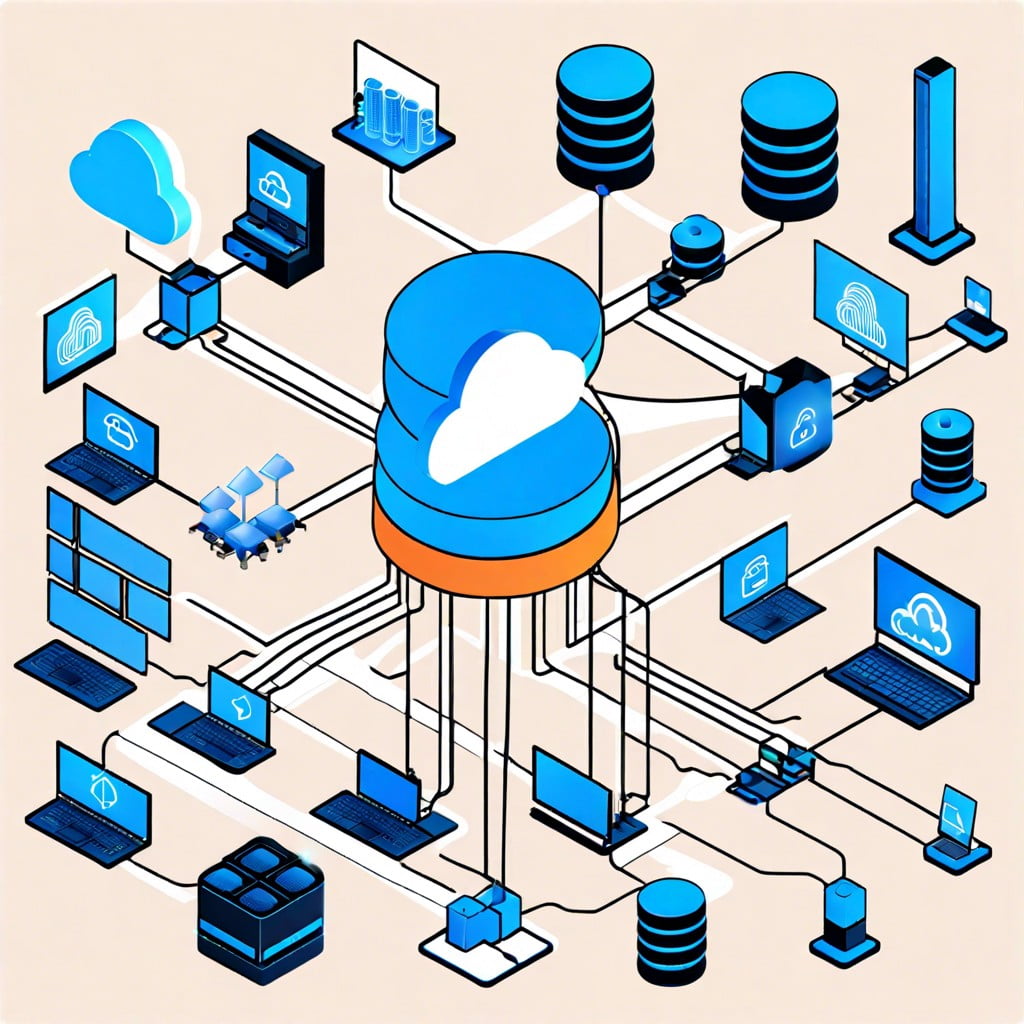Learn how hybrid cloud storage blends the best of both on-premises and cloud solutions to optimize performance and cost.
Hybrid Cloud Storage Architecture

In a hybrid cloud storage setup, data and applications are spread across private and public cloud environments. Think of it as the best of both worlds.
Private cloud: It’s your fortress. Data stored here remains within your controlled environment, ensuring top-notch security and compliance.
Public cloud: Imagine it as the bustling city. Here, you harness scalable resources and flexibility, perfect for handling fluctuating workloads.
Two key components are essential:
Data Tiering: Automatically moves less critical data to the public cloud, reducing costs and keeping your fortress clutter-free.
Unified Management Interface: A single dashboard lets you manage both private and public storage without pulling your hair out.
By combining the strength and security of private clouds with the scalability and cost-effectiveness of public clouds, hybrid architecture is like having your cake and eating it too. And who doesn’t love cake?
Hybrid Cloud Data Syncing
When it comes to syncing data in a hybrid cloud, think of it like playing a duet with a friend. Both your on-premises data center and the cloud need to stay in perfect harmony.
Regular synchronization ensures that data is up-to-date and consistent across both environments. Imagine if one guitarist was out of tune – not good, right?
Data consistently moves between your local storage and the cloud, often through automated processes. The cloud handles scale and flexibility, while your on-prem storage offers control and speed.
Latency is another consideration. Minimal delays keep things running smoothly, like a flawless jam session.
Data replication and mirroring are common techniques, ensuring even the tiniest changes are captured without missing a beat.
Specialized tools and services, often provided by the cloud vendor, make this whole sync process almost magical. They handle errors, optimize performance, and even offer some snazzy visual dashboards.
Sounds almost like a perfectly orchestrated symphony, doesn’t it?
Hybrid Cloud Security
Securing a hybrid cloud environment is like trying to lock the door on a house made of clouds – tricky, but doable. Let’s break it down.
Firstly, encryption is non-negotiable. Encrypt data in transit and at rest to keep prying eyes out.
Next up, think access controls. Limit who gets to see what. Just because Bob from accounting thinks server maintenance sounds fun, doesn’t mean he gets the keys.
Keep tabs on your logs. Monitor activities across both private and public clouds. It’s like having a security camera on your data.
Don’t skimp on regular audits and compliance checks. Policies should be consistent, whether your data is lounging in the private cloud patio or on the public cloud beach.
Lastly, invest in robust VPNs and firewalls. They’ll help your data dodge digital pickpockets as it travels between cloud realms.
Security in a hybrid cloud isn’t a one-and-done deal. It’s a constantly evolving dance. Keep your moves sharp!
Setting Up a Hybrid Cloud
First, choose your providers. Popular options include AWS, Google Cloud, and Azure. Mixing and matching is totally allowed, kind of like picking your favorite ice cream flavors. Just ensure they can talk to each other.
Next, decide what data and workloads go where. Sensitive info in the private cloud, less critical stuff in the public cloud. It’s like having a secret stash and a public library.
Then, set up the VPNs and direct connections between your clouds. This ensures seamless data flow, like a sci-fi teleportation device but for your files and apps.
Finally, deploy management tools. These wrangle everything into a single, manageable dashboard. Think of it as the conductor for your multi-cloud orchestra.
Don’t forget to test thoroughly. You don’t want unpleasant surprises when you hit high traffic or need rapid scaling.
Benefits of Hybrid Cloud Storage
You get the best of both worlds. Imagine having the security of a private cloud but also the scalability of a public cloud. It’s like merging your favorite cozy sweater with a stretchy spandex outfit—pure comfort and flexibility.
Cost-efficiency is another biggie. Why throw money at expensive hardware when you can rent public cloud services as you need them? You only pay for what you actually use, just like a gym membership you may or may not actually use.
Let’s talk speed. Deploying new applications and services becomes faster. How? By shifting workloads to the cloud, you avoid overloading your primary resources.
Data redundancy gets a boost. Having your data in multiple places means fewer headaches when something goes wrong. And let’s face it, something always goes wrong.
Scalability keeps your IT team happy. Need more resources? Scale up. Finished the big project? Scale down. It’s as simple as adjusting the volume on your favorite playlist.
Last but not least, seamless integration. Hybrid cloud solutions often come with tools that help your existing systems play nice with the cloud, so your tech doesn’t end up in a digital tug-of-war. Easy peasy.
Hybrid Cloud Disadvantages
Let’s get real—hybrid cloud storage isn’t always sunshine and rainbows. Here are some quirks and kinks that might throw a wrench in your cloud plans.
Complexity is the name of the game. Managing a blend of on-premises and cloud systems means juggling more balls than ever. You might feel like a circus performer, minus the applause.
Roadblocks ahead! Different infrastructures can lead to compatibility issues. Think of it as trying to fit a square peg in a round hole—not impossible, but not exactly easy peasy either.
Cost considerations can also be a buzzkill. Balancing between cloud and on-prem costs can be like holding onto slippery soap in the shower. Oops, there it goes again!
Security isn’t a walk in the park. While hybrid cloud storage can offer great protection, it also opens up new fronts for potential cyber baddies to sneak in.
So, is it rough around the edges? Sure, but understanding these drawbacks will help you navigate the tricky terrain like a seasoned explorer.
Disaster Recovery Planning
When disaster strikes, having a plan is like having a superhero cape for your data. Hybrid cloud storage swoops in to save the day. Here’s why it’s your trusty sidekick:
Speedy Recovery: Having data in both on-premises and cloud storage means faster access if one goes kaput. No more waiting around like a sidekick in distress!
Cost Efficiency: Hybrid solutions offer a sweet spot, combining the relatively low cost of cloud storage with the speed of on-premises resources. Imagine saving both time and money—feels like hitting the jackpot.
Flexibility: Mix and match what data goes where. Keep critical info close (on-premises) and less urgent stuff in the cloud. Like a perfectly balanced meal, but for your data needs.
Backup and Replication: Automatically duplicate your data to both environments. It’s like having extra lives in a video game. Game Over? Not here!
Choosing a hybrid solution offers redundancy, diversity, and a peace-of-mind pillow to rest your head on during those stormy IT nights. You’ll sleep better knowing your data’s got backup…and then some.




